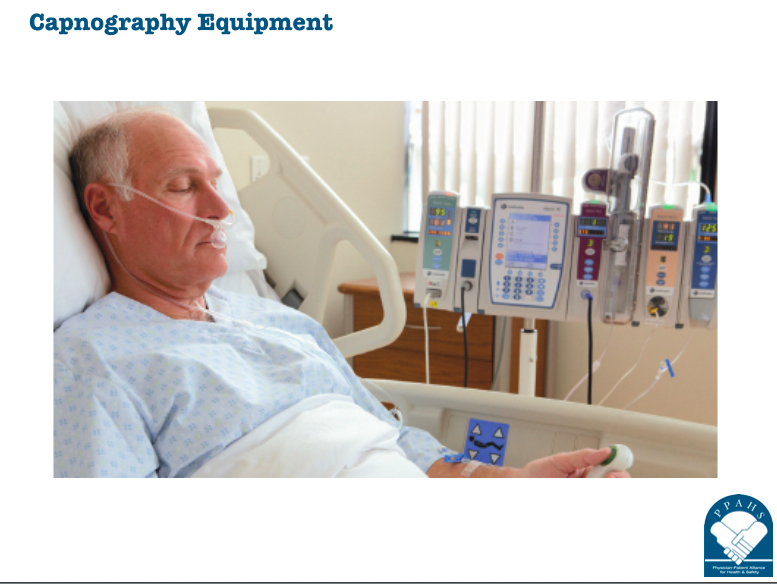The Physician-Patient Alliance for Health & Safety recently interviewed Peggy Lange, RT (Director of the Respiratory Care Department, St. Cloud Hospital) about a project that examined acute response team (ART) calls regarding patients who had received procedural or conscious sedation 24 hours prior to the event.
As Ms. Lange wrote in her article published in ADVANCE for Respiratory Care and Sleep Medicine, “Culture of Safety Includes Capnography”:
“We looked at patient monitoring practices in the outpatient procedural areas and we addressed the very real issue of too many alarms on the hospital patient floor. We also undertook a literature review for the project as we prepared to consider implementing capnography outside the operating room at our institution.”
For the project, St. Cloud Hospital brought together a team of clinicians that included physicians, nurses, respiratory therapists, and pharmacists who represented different clinical areas like pain, sedation, endoscopy, and surgery.
In this interview, Ms. Lange discussed 5 key learnings from this project:

Key Learning #1 – Capnography Assists with Assessment of the Quality of Ventilation
Ms. Lange said that their review of the relevant literature and their experience showed that monitoring with capnography is a valuable tool to assess the patient’s quality of ventilation:
“We reviewed the literature and then budgeted through normal channels for approval for the equipment, and then worked closely with the surgical floor for the trial period. We found that the literature talked about CO2 monitoring was providing an earlier indicator of respiratory compromise before the patient became hypoxic.
“So, even before oximetry would be a reading, CO2 monitoring provided that earlier indication. We found that it was recommended as a tool for procedural sedation. And during the recovery for sedation, we found that end tidal CO2 monitoring was recommended to assist with the quality of ventilation. It was a standard of care for anesthesia for a number of years for intubated and mechanically vented patients, and it’s also in the ACLS guidelines for cardiopulmonary arrest management.”
Key Learning #2 – Monitor Patients Continuously, Not Intermittently
To be effective, capnography monitoring should be done continuously and not intermittently, said Ms. Lange:
“We know that intermittent monitoring can stimulate the patient to a higher level of consciousness. But again, when they’re left alone, they can experience that respiratory depression. We want people to document the trended numbers, not just the numbers when you stimulate somebody, because it’s not giving the full picture to the next caregiver.”
Key Learning #3 – Understanding the Half-Lives of Sedatives and Opioids Prevents Over Medication
Ms. Lange emphasized that understanding the half-lives of sedatives and opioids may prevent over medication:
“What we’ve found for fentanyl is the half-life is from 3 to 12 hours and certainly 12 hours seems like a long time. So, we concentrated at about the three hours. What that would mean is if I was having an endoscopy procedure at noon and I received 200 of fentanyl, the half-life is 3 hours.
“So by 3 o’clock in the afternoon, my drug on board would be half of that, so 100 of those micrograms. Then 3 more hours at 6 o’clock, it would be 50. And at 9 o’clock, it would be 25 and so on. So, it’s a three-hour half-life.
“For the versed, that half-life is 2 hours, unless the patient is obese and then the half life becomes 4 hours. So if you receive two milligrams at noon, then at three o’clock you would still have one on board.
“For hydromorphone, the half life is 3 hours, and again we saw in some of our records that patients would received a second dose of hydromorphone because of their pain at under 15 minutes. So, before the first one even had that onset time. And then they would give it more without realizing that half-life of medication. We did a lot of education about half-life of medications.
Key Learning #4 – Patient Monitoring is About a Trend, Not a Number
Documentation should reflect trends and interventions, said Ms. Lange:
“We know that intermittent monitoring can stimulate the patient to a higher level of consciousness. But again, when they’re left alone, they can experience that respiratory depression. We want people to document the trended numbers, not just the numbers when you stimulate somebody, because it’s not giving the full picture to the next caregiver.”
Key Learning #5 – Educate Staff to Recognize Respiratory Compromise
Ms. Lange highlighted the importance of recognizing the signs of respiratory compromise and ensuring staff act effectively to prevent respiratory depression:
“the education that’s needed is still that a lot of caregivers, when oxygen saturation goes down, they turn up the oxygen, and it kinds of masks the event that’s happening. And, you need to think of ventilation and profusion and use all these pieces together.
“… narcotics and sedatives can cause respiratory depression, especially in a post-op period of time. I encourage all the caregivers to really think that they’re in intensive care environment for those first few hours until that patient recovers or starts waking up.”
In concluding the interview, Ms. Lange encouraged clinicians to monitor their patients with capnography:
“I do think that capnography is a tool that is very beneficial. I grew up in the time where pulse oximetry was a new tool and that was presented to us and it was presented as this wonderful, wonderful tool …
“There are some naysayers in the world of understanding capnography, but I’ve seen it work for our facility. There are many articles out there being used in endoscopy suites, in PCA monitoring, and again, whenever a caregiver is concerned to be able to put it on.”
For a transcript of the interview, please click here.
To listen to the interview with Ms. Lange on YouTube, please click here.